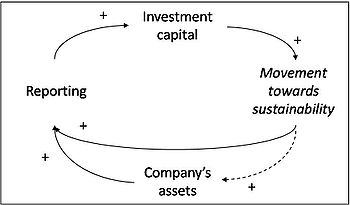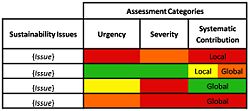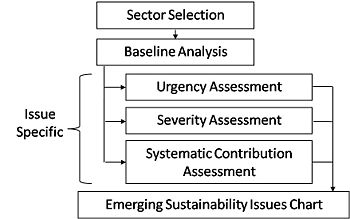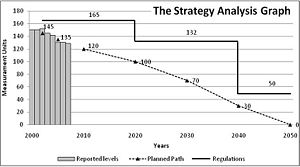
Strategic Sustainable Investing
Encyclopedia
Strategic sustainable investing (SSI) is an investment strategy
that recognizes and rewards leading companies that are moving society towards sustainability. SSI relies on a consensus-based scientific definition of sustainability
, and the assumption that ‘Backcasting
from Principles of Sustainability’, whereby a vision of a sustainable future is set as the reference point for developing strategic actions, is the preferred approach to strategically move a company towards sustainability. It was developed by researchers at the Blekinge Institute of Technology
in Sweden.
Characteristics of SSI:
• Lower sustainability risk exposure
• A definition of sustainability based on scientific consensus
• Primarily driven by movement towards sustainability
• Considers financial, ESG, and strategy analysis
SSI operates by prioritizing investment capital allocation to companies that are taking the lead in shifting away from unsustainable behaviour towards new ways of doing business. This capital allocation will provide an incentive for companies to move forward in a sustainable direction. This movement is reported in corporate social responsibility
(CSR) and other extra-financial reports, but is also recorded in traditional areas of a firm’s financial balance sheets.
By incorporating sustainability investment and returns into traditional financial reporting, a clearer picture of the bottom-line impact of a company’s actions towards sustainability is made available. In this positive reinforcing loop, greater investor returns and increased movement towards sustainability are generated with every cycle.

Causal loop diagram
illustrating the strategic sustainable investment
Institutional investor
s, such as mutual and pension funds, take a longer-term position on investments and are thus ideally suited to incorporate SSI strategies.
, made popular by The Natural Step
and its founder Dr. Karl-Henrik Robèrt
.
This strategy resembles socially responsible investing
(SRI), a growing practice amongst ethical investors. Nevertheless, SSI recognizes the gaps of SRI pointed by several academics and practitioners and presents some alternatives.
Main differences between traditional investment strategies, SRI and SSI:
a. The recognition of companies with true leading strategies for a sustainable future
b. A robust and well defined link must be made between movement towards sustainability and higher investment returns
The SSI analysis tool addresses the first gap by measuring a company’s strategy for addressing sustainability. It allows investors to recognize which companies are leading the transition in a new direction, and which are most likely to be strong performers in tomorrow’s market.
This tool is divided in two main parts: the emerging sustainability issue (esi) chart and the strategy analysis component:
 The Sectoral Emerging Sustainability Issue (ESI) chart is used to identify which aspects of a determined market sector will become a socio-environmental problem. In the common sense, an issue is called ‘emergent’ when it gets media exposure. Instead, the Tool relies on scientific Principles of sustainability to identify what is emergent.
The Sectoral Emerging Sustainability Issue (ESI) chart is used to identify which aspects of a determined market sector will become a socio-environmental problem. In the common sense, an issue is called ‘emergent’ when it gets media exposure. Instead, the Tool relies on scientific Principles of sustainability to identify what is emergent.
It exposes which Sustainability Issues present high risks for companies within that sector in the short-term; as well as which Issues will be emerging in the medium and long-terms. Due to differences within a sector, the Sectoral ESI Chart should be made as specific as needed, being flexible to account for various geographical locations and sub-sector subtleties.
The process of composing an ESI chart follows:
Once a sector is selected for an ESI analysis, a list of relevant sustainability issues is assembled. This baseline analysis will result in a list of issues outlining the subject sector’s strengths and concerns that impact society and the environment. Next, prioritization colours are assigned to each sustainability issue: red for very high priority; orange for high priority; yellow for medium priority, and green for low priority according to its assessment in each of three categories: urgency, severity, and systematic contribution.
Urgency assesses the time frame pressing each Issue. The severity assesses the seriousness of the Issue, in terms of its potential consequences for the environment, society, and companies within that sector. The systematic contribution is used to gauge the sector’s contribution to the overall Issue.
 To fill out the Chart, Researchers follow this process flow.
To fill out the Chart, Researchers follow this process flow.
The subject company’s actions are seen through the lens of strategic sustainable development
, and thus three questions are emphasized as a mental guideline:
a. Does this action provide a competitive return on investment (ROI)?
b. Is this action taking the subject company in the right direction?
c. Is this action a versatile platform?

Strategic Sustainable Development
Investment strategy
In finance, an investment strategy is a set of rules, behaviors or procedures, designed to guide an investor's selection of an investment portfolio...
that recognizes and rewards leading companies that are moving society towards sustainability. SSI relies on a consensus-based scientific definition of sustainability
Sustainability
Sustainability is the capacity to endure. For humans, sustainability is the long-term maintenance of well being, which has environmental, economic, and social dimensions, and encompasses the concept of union, an interdependent relationship and mutual responsible position with all living and non...
, and the assumption that ‘Backcasting
Backcasting
Backcasting starts with defining a desirable future and then works backwards to identify policies and programs that will connect the future to the present. The fundamental question of backcasting asks: "if we want to attain a certain goal, what actions must be taken to get there?"Forecasting is the...
from Principles of Sustainability’, whereby a vision of a sustainable future is set as the reference point for developing strategic actions, is the preferred approach to strategically move a company towards sustainability. It was developed by researchers at the Blekinge Institute of Technology
Blekinge Institute of Technology
The Blekinge Institute of Technology is a public, state funded Swedish Institute of technology in Blekinge with more than 8,000 students and offers 350 courses in 40 educational programmes in five schools at two campuses located in Karlskrona and Karlshamn.The institute focuses on applied...
in Sweden.
The strategic sustainable investment system
SSI outlines that the financial investment will offer a competitive risk-adjusted return, while providing investment capital to companies that are actively attempting to become more sustainable. It implies lower exposure to sustainability-related risks and it considers financial metrics together with environmental, social, and governance (ESG) aspects, as well as strategy analyses to educate investment decision-making.Characteristics of SSI:
• Lower sustainability risk exposure
• A definition of sustainability based on scientific consensus
• Primarily driven by movement towards sustainability
• Considers financial, ESG, and strategy analysis
SSI operates by prioritizing investment capital allocation to companies that are taking the lead in shifting away from unsustainable behaviour towards new ways of doing business. This capital allocation will provide an incentive for companies to move forward in a sustainable direction. This movement is reported in corporate social responsibility
Corporate social responsibility
Corporate social responsibility is a form of corporate self-regulation integrated into a business model...
(CSR) and other extra-financial reports, but is also recorded in traditional areas of a firm’s financial balance sheets.
By incorporating sustainability investment and returns into traditional financial reporting, a clearer picture of the bottom-line impact of a company’s actions towards sustainability is made available. In this positive reinforcing loop, greater investor returns and increased movement towards sustainability are generated with every cycle.

Causal loop diagram
Causal loop diagram
A causal loop diagram is a causal diagram that aids in visualizing how interrelated variables affect one another. The diagram consists of a set of nodes representing the variables connected together...
illustrating the strategic sustainable investment
Institutional investor
Institutional investor
Institutional investors are organizations which pool large sums of money and invest those sums in securities, real property and other investment assets...
s, such as mutual and pension funds, take a longer-term position on investments and are thus ideally suited to incorporate SSI strategies.
Theory background
The theoretical foundation of SSI is strongly linked to strategic sustainable developmentStrategic Sustainable Development
Strategic sustainable development is a strategic approach to sustainable development and is a field of study that exists within the public domain. A number of authors, researchers and practitioners identify with this approach...
, made popular by The Natural Step
The Natural Step
The Natural Step is a non-profit organization founded in Sweden in 1989 by scientist Karl-Henrik Robèrt. Following publication of the Brundtland Report in 1987, Robèrt developed The Natural Step framework, setting out the system conditions for the sustainability of human activities on Earth;...
and its founder Dr. Karl-Henrik Robèrt
Karl-Henrik Robèrt
Karl-Henrik Robèrt, M.D., Ph.D. , is a Swedish cancer scientist and an important figure in the worldwide sustainability movement. He is known for The Natural Step, a framework that lays out the system conditions for sustainability, that arose from his consultations with municipalities, businesses,...
.
This strategy resembles socially responsible investing
Socially responsible investing
Socially responsible investing , also known as sustainable, socially conscious, or ethical investing, describes an investment strategy which seeks to consider both financial return and social good....
(SRI), a growing practice amongst ethical investors. Nevertheless, SSI recognizes the gaps of SRI pointed by several academics and practitioners and presents some alternatives.
Main differences between traditional investment strategies, SRI and SSI:
| Traditional | SRI | SSI | |
|---|---|---|---|
| Sustainability definition | sustainability is not considered | Lack of clear definition | A definition based on scientific consensus |
| Primary driver | Maximize Return on Investment | Ethical values | Movement towards sustainability |
| Analysis performed | Financial analysis | ESG analysis Financial analysis |
ESG analysis Financial analysis Strategy analysis |
| Sustainability risk exposure | Higher exposure | Variable exposure | Lower exposure |
SSI analysis tool
In order to evolve current SRI and traditional investment practices into Strategic Sustainable Investment, two gaps must be considered:a. The recognition of companies with true leading strategies for a sustainable future
b. A robust and well defined link must be made between movement towards sustainability and higher investment returns
The SSI analysis tool addresses the first gap by measuring a company’s strategy for addressing sustainability. It allows investors to recognize which companies are leading the transition in a new direction, and which are most likely to be strong performers in tomorrow’s market.
This tool is divided in two main parts: the emerging sustainability issue (esi) chart and the strategy analysis component:
ESI chart

It exposes which Sustainability Issues present high risks for companies within that sector in the short-term; as well as which Issues will be emerging in the medium and long-terms. Due to differences within a sector, the Sectoral ESI Chart should be made as specific as needed, being flexible to account for various geographical locations and sub-sector subtleties.
The process of composing an ESI chart follows:
Once a sector is selected for an ESI analysis, a list of relevant sustainability issues is assembled. This baseline analysis will result in a list of issues outlining the subject sector’s strengths and concerns that impact society and the environment. Next, prioritization colours are assigned to each sustainability issue: red for very high priority; orange for high priority; yellow for medium priority, and green for low priority according to its assessment in each of three categories: urgency, severity, and systematic contribution.
Urgency assesses the time frame pressing each Issue. The severity assesses the seriousness of the Issue, in terms of its potential consequences for the environment, society, and companies within that sector. The systematic contribution is used to gauge the sector’s contribution to the overall Issue.

Strategic plan
The Strategic Plan element assesses the subject company’s planned goals in relation to the emerging sustainability issue (ESI). The qualitative description includes, but is not limited to, information regarding: public commitments planned operational and business initiatives, political action/ lobbying, and third party partnerships (with NGOs, consultative firms etc.). There is also a comment on the subject company’s core business in relation to the ESI; as this will assist in determining the subject company’s exposure to the emerging risk.Strategic actions
The strategic actions element looks at assessing the subject company’s recent actions taken in relation to the emerging sustainability issue (ESI), thus determining whether the subject company is ‘walking the talk’ in comparison to the vision and goals outlined.The subject company’s actions are seen through the lens of strategic sustainable development
Strategic Sustainable Development
Strategic sustainable development is a strategic approach to sustainable development and is a field of study that exists within the public domain. A number of authors, researchers and practitioners identify with this approach...
, and thus three questions are emphasized as a mental guideline:
a. Does this action provide a competitive return on investment (ROI)?
b. Is this action taking the subject company in the right direction?
c. Is this action a versatile platform?
Strategy analysis graph
The strategy analysis graph shows the subject company’s planned path for dealing with the ESI, tangible progress made, and if existent, government regulations. The trajectory of the subject company’s planned path reveals the extent of their future risk exposure. This graph is placed in the center of the strategy analysis page.
Assurance assessment
The assurance assessment provides an overall impression of the validity of the information gathered. This assessment may be applied if the data is verified by an external third party, or if discrepancy is evident between different sources of information used on the report.External links
Strategic Sustainable Development
Strategic Sustainable Development
Strategic sustainable development is a strategic approach to sustainable development and is a field of study that exists within the public domain. A number of authors, researchers and practitioners identify with this approach...

